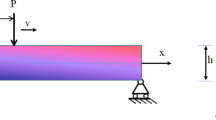Abstract
In this paper, the weight function method is used for two-dimensional mixed-mode crack analyses of clastostatic and elastodynamic problems. By the use of the Laplace transformation method and an indirect boundary element method, the dynamic stress intensity factors for a finite sheet containing a central or an edge crack are evaluated. A Green's function method is introduced which depends on the weight function for an impulsive applied load. The Green's function can be used to determine stress intensity factors for arbitrary time dependence of the boundary conditions. The stress intensity factors obtained by the weight function method are compared where possible, with existing solutions.
Similar content being viewed by others
References
H.F., Bueckner, A novel principle for the computation of stress intensity factors, Zeitschrift fur Angewandte Mathematik und Mecanik 50 (1970) 529–546.
J.R., Rice, Some remarks on elastic crack-tip stress fields, International Journal of Solids and Structures 8 (1972) 751–758.
P.C. Paris, R.M. McMeeking, and H. Tada, The weight function method for determining stress intensity factors, in Cracks and Fracture, J.L. Swedlow and M.L. Williams (eds.) STP 601, ASTM (1976) 471–489.
Y., Bortmann and L., Banks-Sills, An extended weight function method for 2D and 3D-problems, Journal of Applied Mechanics 50 (1983) 907–909.
G.T., Sha and C.T., Yang, Weight function calculations for mixed mode fracture problems with the virtual crack extension technique, Engineering Fracture Mechanics 21 (1985) 1119–1149.
M.H., Aliabadi, D.J., Cartwright and D.P., Rooke, Fracture-mechanics weight-function by the removal of singular fields using boundary element analysis, International Journal of Fracture 40 (1989) 271–284.
D.P., Rooke and M.H., Aliabadi, The use of fundamental fields to obtain weight functions for mixed-mode cracks, International Journal of Engineering Science 32 (1994) 155–166.
M.H., Aliabadi and D.P., Rooke, Numerical Fracture Mechanics, Computational Mechanics Publications, Southampton and Kluwer Academic Publishers, Dordrecht (1991).
P.H., Wen, M.H., Aliabadi and D.P., Rooke, A fictitious stress and displacement discontinuity method for dynamic crack problems, in Boundary Element Method XVI, C.A., Brebbia (ed.), Computational Mechanics Publications, Southampton (1994) 469–476.
Y. Murakami, Stress Intensity Factors Handbook, Pergamon Press (1987).
J., Dominguez, Boundary Elements in Dynamics, Computational Mechanics Publications, Southampton (1993).
S., Hirose and J.D., Achenbach, Time-domain boundary element analysis of elastic wave interaction with a crack, International Journal of Numerical Methods in Engineering 28 (1989) 629–644.
S., Hirose and J.D., Achenbach, Acoustic emission and near-tip elastodynamic fields of a growing pennyshaped crack, Engineering Fracture Mechanics 39 (1991) 21–36.
P., Fedelinski, M.H., Aliabadi and D.P., Rooke, The dual boundary element method for dynamic analysis of cracked pin-loaded lugs, in Localized Damage III, Computer Aided Assessment and Control, M.H., Aliabadi et al. (eds.), Computational Mechanics Publications, Southampton (1994) 571–520.
J., Sladek and V., Sladek, A boundary integral equation method for dynamic crack problems, Engineering Fracture Mechanics 27 (1987) 269–277.
P., Fedelinski, M.H., Aliabadi and D.P., Rooke, The dual boundary element method: Ĵ-integral for dynamic stress intensity factors, International Journal of Fracture 65 (1994) 369–381.
F., Durbin, Numerical inversion of Laplace transforms: an efficient improvement to Dubner and Abate's method, The Computer Journal 17 (1974) 371–376.
Y.M., Chen, Numerical computation of dynamic stress intensity factors by a Lagrangian finite-difference method(the HEMP CODE), Engineering Fracture Mechanics 7 (1975) 653–660.
L.B., Freund and J.R., Rice, On the determination of elastodynamic crack tip stress fields, International Journal of Solids and Structures 10 (1974) 411–417.
H.J., Petroski, J.L., Glazik and J.D., Achenbach, Construction of a dynamic weight function from a finiteelement solution for a cracked beam, Journal of Applied Mechanics 47 (1980) 51–56.
Author information
Authors and Affiliations
Rights and permissions
About this article
Cite this article
Wen, P.H., Aliabadi, M.H. & Rooke, D.P. Application of the weight function method to two-dimensional elastodynamic fracture mechanics. Int J Fract 76, 193–206 (1996). https://doi.org/10.1007/BF00048286
Received:
Accepted:
Published:
Issue Date:
DOI: https://doi.org/10.1007/BF00048286




